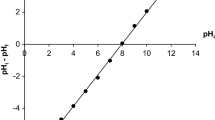Abstract
Biological devulcanization of ground tires (GTs) was evaluated by eleven different bacteria belonging to the genera Thiobacillus, Gordonia, Nocardia, Amycolaptopsis and Pseudomonas. The GTs were treated by each bacterium in a mineral medium and devulcanization was measured by increasing the sulfate of the medium and decreasing the sulfur of the GTs. The effects of incubation time (10 and 20 days) and the percent of ground tire in the medium (0.5 and 5 w/v %) on desulfurization were investigated. No significant changes were observed after 10 days of incubation. The total sulfur contents of all bio-treated GTs were decreased by 6–21% in 0.5% GTs after 20 days of incubation. While in 5% GTs, the total sulfur contents were mainly decreased using Thiobacillus ferroxidans DSMZ 583 and PTCC 1647 up to 27 and 15%, respectively. SEM photograph further indicated a good coherency interface between the bacteria and the GTs. Subsequently, Taguchi method was applied for the optimization of the culture condition of DSMZ 583. An L12 orthogonal array was performed by which the effects of eleven factors in two levels were evaluated. It was found that the amount and mesh size of GTs are the most important factors in biological devulcanization of ground tires.

Similar content being viewed by others
References
Ramarad S, Khalid M, Ratnam CT, Luqman Chuah A, Rashm W (2015), Waste tire rubber in polymer blends: a review on the evolution, properties and future. Prog Mater Sci 72:100
Shah AA, Hasan F, Shah Z, Kanwal N, Zeb S (2013) Biodegradation of natural and synthetic rubbers: a review. Int Biodeterior Biodegradation 83:145
Mull MA, Stuart K, Yehia AA (2002) Fracture resistance characterization of chemically modified crumb rubber asphalt pavement. J Mater Sci 37:557
Wu B, Zhou MH (2009) Recycling of waste tyre rubber into oil absorbent. Waste Manag 29:355
Minghan H, Suhe Z, Chao L, Bingwu W, Chu Y, Yaqin W (2014) The influence of different Tween surfactants on biodesulfurization of ground tire rubber by Sphingomonas sp.. Polym Degrad Stab 107:91
Medhat MH, Raouf OA, Abdel Aal SE, El-Masry AM, Fathy ES (2013) Mechanochemical devulcanization and gamma irradiation of devulcanized waste rubber/high density polyethylene thermoplastic elastomer. Ind Eng Chem 19:1722
Cui X, Zhao S, Wang B (2016) Microbial desulfurization for ground tire rubber by mixed consortium-Sphingomonas sp. and Gordonia sp.. Polym Degrad Stab 128:165
Tsuchii A, Tokiwa Y (2001) Microbial degradation of tyre rubber particles. Biotechnol Lett 23:963
Holst O, Stenberg B, Christiansson M (1998) Biotechnological possibilities for waste tire-rubber treatment. Biodegradation 9:301
Chu Y, Suhe Z, Yaqin W, Bingwu W, Meiling W, Minghan H (2013) Microbial desulfurization of waste latex rubber with Alicyclobacillus sp.. Polym Degrad Stab 98:1724
Loffler M, Straube G, Straube E (1993) Biohydrometallurgical technologies. Proceedings of an International Biohydrometallurgy Symposium. Biometallurgical Symposium (Jackson Hole, Wyo. USA)
Li Y, Zhao S, Wang Y (2011) Microbial desulfurization of ground tire rubber by Thiobacillus ferrooxidans sp.. Polym Degrad Stab 96:1662
Li Y, Zhao S, Wang Y (2012) Improvement of the properties of natural rubber/ground tire rubber composites through biological desulfurization of GTR. J Polym Res 19:1
Li Y, Zhao S, Wang Y (2012) Microbial desulfurization of ground tire rubber by Sphingomonas sp.: a novel technology for crumb rubber composites. J Polym Environ 20:372
Rifaat HM, Yosery MA (2004) Identification and characterization of rubber degrading Actinobacteria. Appl Ecol Environ Res 2:63
Arenskotter M, Baumeister D, Berekaa MM, Potter G, Kroppenstedt RM, Linos A, Steinbuchel A (2001) Taxonomic characterization of two rubber degrading bacteria belonging to the species Gordonia polyisoprenivorans and analysis of hyper variable regions of 16S rDNA sequences. FEMS Microbiol Lett 205:277
Linos A, Berekaa MM, Reichelt R, Keller U, Schmitt J, Flemming HC, Kroppenstedt RM, Steinbüchel A (2000) Biodegradation of cis-1,4- Polyisoprene rubber by distinct actiomycetes: microbial strategies and detailed surface analysis. Appl Environ Microbiol 66:1639
Bode HB, Zeeck A, Pluckhan K, Jendrossek D (2000) Physiological and chemical investigation into microbial degradation of synthetic poly (cis-1,4-isoprene). Appl Environ Microbiol 66:3680
Heisey RM, Papadatos S (1995) Isolation of microorganisms able to metabolize purified natural rubber. Appl Environ Microbiol 61:3092
Tsuchii A, Suzuki T, Takeda K (1985) Microbial degradation of natural rubber vulcanized. Appl Environ Microbiol 50:965
Tsuchii A, Tokiwa Y (2005) Two-step cultivation method for microbial disintegration of tire rubber particles. Polym Environ 13:75
Roy RK (2001) Design of experiments using the Taguchi approach. Wiley, Hoboken
WPCF (1980) Standard methods for the examination of water and wastewater, Chairman JOSEPH J.CONNORS, 15th edn p 438
Jiang G, Zhao S, Luo J, Wang Y, Yu W, Zhang C (2010) Microbial Desulfurization for NR Ground rubber by Thiobacillus ferrooxidans. J Appl Polym Sci 116:2768
Christiansson M, Stenberg B, Wallenberg LR, Holst O (1998) Reduction of surface sulphur upon microbial devulcanization of rubber materials. Biotechnol Lett 20:637
Hedrich S, Johnson DB (2013) Acidithiobacillus ferridurans sp. nov., an acidophilic iron-, sulfur- and hydrogen-metabolizing chemolithotrophic gammaproteobacterium. Int J Syst Evol Microbiol 63:4018–4025
Arenskötter M, Bröker D, Steinbüchel A (2004) Biology of the metabolically diverse Genus Gordonia. Appl Environ Microbiol 70:3195–3204
Tseng M, Yang SF, Li WJ, Jiang CL (2006) Amycolatopsis taiwanensis sp. nov., from soil, nternational. J Syst Evol Microbiol 56:1811–1815
Franco CMM, Labeda DP (2014) The order Pseudonocardiales. In: Rosenberg E et al The prokaryotes. Springer, Berlin, pp 743–860
Berekaa MM, Barakaat A, El-Sayed SM, El-Aassar SA (2005) Degradation of natural rubber by Achromobacter sp. NRB and evaluation of culture conditions. Pol J Microbiol 54:55
Ghavipanjeh F, Ziaei Rad Zh, Ghavipanjeh F, Pazouki M (2015) Evaluation of Biodevulcanized waste ground tire in revulcanization. Iran J Eng Trans A 28:1
Acknowledgements
The authors are grateful for financial support from Iran Tire Manufacturing Company under project No. 569001.
Author information
Authors and Affiliations
Corresponding author
Rights and permissions
About this article
Cite this article
Ghavipanjeh, F., Ziaei Rad, Z. & Pazouki, M. Devulcanization of Ground Tires by Different Strains of Bacteria: Optimization of Culture Condition by Taguchi Method. J Polym Environ 26, 3168–3175 (2018). https://doi.org/10.1007/s10924-017-1169-0
Published:
Issue Date:
DOI: https://doi.org/10.1007/s10924-017-1169-0




